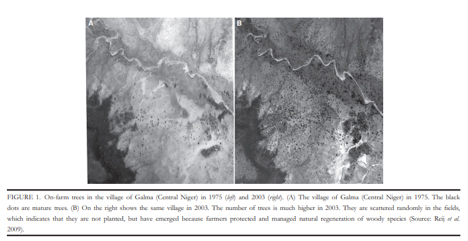Up-scaling the Benefits of Agroforestry through Farmer Managed Natural Regeneration
Reij, Chris, and Dennis Garrity. 2016. Scaling up Farmer-Managed Natural Regeneration in Africa to Restore Degraded Landscapes. Biotropica 48 (6): 834–43
Africa presents opportunities and challenges for forest landscape restoration, including agroforestry. In Southern Niger, small farmers have been protecting and managing the trees and shrubs that naturally regenerate on their land since the mid 80’s. 25 years later, 5 million hectares of agroforests have been established across the landscape, dramatically altering the ecology and improving drought resistance in agricultural systems. In the Zinder region, a crisis in 1980 led to land abandonment and a decrease in top-down forestry services for villages. More available land combined with farmers perceiving trees as their own (instead of as state property) led farmers to enable natural regeneration on their lands. But in the Maradi Region, an NGO exchanged food for protecting trees in the region. While this intervention initially increased forest cover, when the assistance ended the majority of farmers cut down the regenerating trees.
Integrating trees on farms and in agroforestry systems can improve farming productivity and increase drought resilience, making agroforestry an important farm management system that also has the potential to fight climate change and meet the ambitious global reforestation initiatives. Agroforestry systems can be created by actively planting trees or through assisted regeneration. Both approaches imply engagement from the farmers. In this article, the authors identify degraded landscapes that have undergone the creation of large-scale agroforestry parklands over several decades. These case studies presented above provide an opportunity to understand how we can promote agroforestry adoption at the landscape scale.
Synthesizing across multiple case studies, the authors note that the tree species that regenerate naturally are initially dependent on the local species pool, but ultimately dependent on which species farmers decide to keep. One key benefit of agroforestry in West Africa is household food security, as tree cover can increase gain production, livestock fodder, and edible fruit. These benefits may be particularly crucial sources of income during drought years. In addition to immediate benefits for livelihood, agroforestry also promotes ecosystem services, including soil conservation, microclimate regulation, carbon sequestration, and biodiversity. Creating agroforestry systems by protecting natural regeneration does not require as much external support for the farmers as active restoration, since the costs are creating barriers to protect the trees and pruning the canopy size and shape. Altogether, the authors point to the enormous potential for natural regeneration to restore ecosystem service to large areas of land in poor regions. Ensuring the long-term success of natural regeneration initiatives will require building grassroots movements to promote tree cover, changing policies to promote adoption of agroforestry, and development of agroforestry value chains.
The PARTNERS connection
In line with PARTNERS objectives, we encourage our findings to be considered in public policies favoring socio-ecological strategies for the sustainable management of ecosystems and agro-forestry landscapes in the tropics. These strategies must consider social and economic dimensions to achieve this sustainability and the development of local communities. Our results were presented in the symposium on “Low-cost restoration via natural regeneration”, organized by PARTNERS in Rio de Janeiro, Brazil, in 2014, and published in the special issue “The Role of Natural Regeneration in Large-scale Forest and Landscape Restoration: Challenge and Opportunity” organized by PARTNERS and published in the journal Biotropica in 2016.



